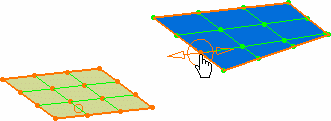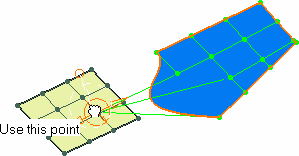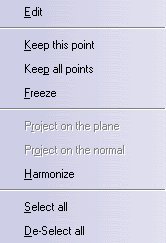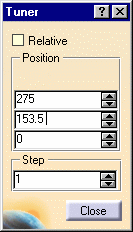Open the FreeStyle_Part_30.CATPart document.
-
Select both surfaces.
-
Click the Control Points icon
 .
. -
Click the Snap on Ctrl points in the Dashboard.
-
On the blue surface select only one control point.
All other points turn to green and the selected point is highlighted.
-
Move this point close to the other surface.
As the pointer nears a control point onto the other surface, the Use this point text is displayed, and the point on the second surface is identified by a dotted circle.
If you release the mouse button then, the selected point on the blue surface is located at the orthogonal projection to the point detected on the second surface, onto the support as defined in the dialog box. This projected location is identified by a red circle connected to the detected point on the second surface by a dotted line.
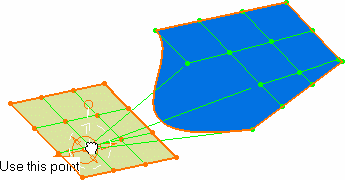
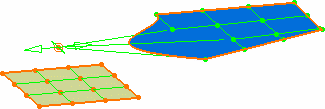
Using a point for a projection
Resulting deformed surface
-
Press the Control key. the text changes to Snap on this point.
In this case, the selected point is moved exactly to the location of the point on the second surface identified as the point to be snapped to, as if they were merged.
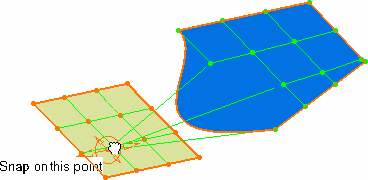
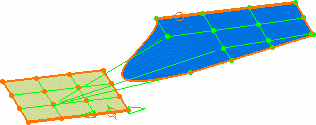
Snapping onto a point
Resulting deformed surface
The snap onto a point is possible only when the selected point is not constrained onto a specific element. For example, when matching the two surfaces, the manipulators are only allowed to move, and snap on points, along the other surface's edges. Using a point or snapping onto it is identical, as the manipulators are constrained on the surface's edge:
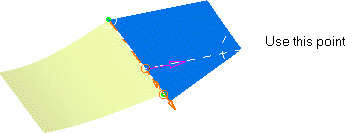
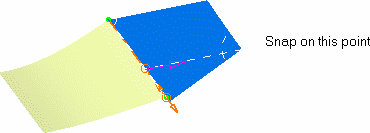
Using the Shift key to use a point
Using the Shift + Ctrl keys to snap onto a point
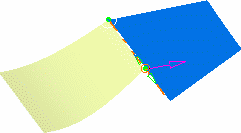
Resulting matched surface
- Edit: the Tuner dialog box is displayed, letting you
-specify the exact position of the control point in space
- define a step value by which a control point/mesh line moves (Step field).
Once the value has been defined in the Tuner dialog box, press and hold the Shift key then click one of the manipulator's arrow to move the selected control point by the defined step value.
- Keep this point: allows you to keep the current point at
its location.
A Point.xxx appears in the specification tree
- Keep all points: allows you to keep all the
control points
All the points appear in the specification tree
- Freeze: enables to set control points inactive according to the defined constraint.
- Project on the plane
- Project on the normal
- Harmonize
- Select All: enables to select all control points
- De-Select All: enables to de-select all control points
Note that using the contextual menu on an element, when several element have been selected, applies the chosen capability on this element only, and not on the whole selection. However, if you apply the same capability from the Control Points dialog box, a given all the selected elements will be affected.
- Use the F5 key to move the manipulators into a different plane of the compass, when they are not constrained within a given direction, see Managing the Compass.
- Use the Shift key to activate/deactivate temporarily the
auto-detection capability on the point you are currently trying to snap,
or not, to another element.
When no auto-detection mode is active, manipulators will be snapped onto corners or onto another manipulator.
Snapping is available in P2 mode only.
